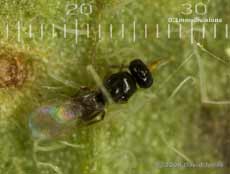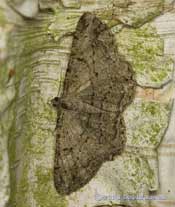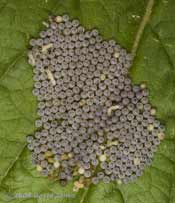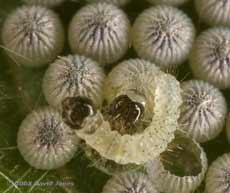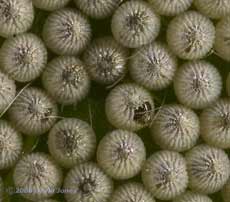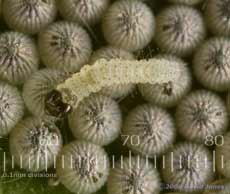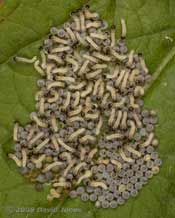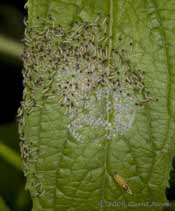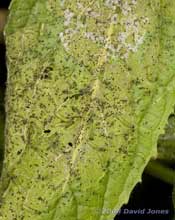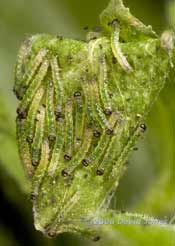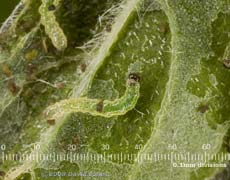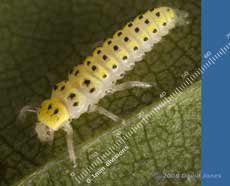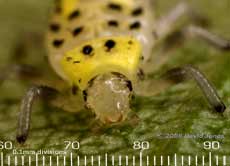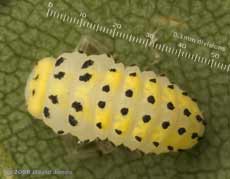Go to the last entry on this page .....Go to previous entry20 August - A dull and sometimes damp day, although I did get out to record a few things for the diary.
First of all, in addition to the Garden Bumble and Carder Bees, and despite the cloud, there were small numbers of solitary bees visiting flowers, like this one on a Cosmos bloom. The crab spider continues its vigil on the blooms, moving to a fresh one as each flower starts withering.
Again, I spent some time checking the Water Mint plants, coming across this shieldbug, at least a late instar nymph of the Green Shieldbug which was crawling about amongst the foliage.
This hoverfly made a brief appearance, although it didn't stay for very long, giving me the chance to get just the one picture. Its lemon yellow colouring provided a great contrast to its otherwise black body. As I didn't get a dorsal (back) view I can't be absolutely sure of its ID, but I think it is possibly Chrysotoxum festivum.
A more familiar, large hoverfly made a rather more camera-friendly visit to the Water Mint, although even that didn't provide me with a dorsal view. I photographed a Volucella inanis (Inane Hoverfly) on the 16th. On that occasion it was the male, but this is the female (unless I'm very much mistaken),
with a larger spacing between its compound eyes.
I was able to get in quite close today and this allowed me to see that its small antennae are feathery, something I hadn't noted before on hoverflies.
Yesterday I recorded the presence of Hazel Sawfly larvae on the Birch but didn't include a closer view of one, so here is one taken today. There are nineteen of them in the group (although that group is split between two adjacent leaves at the moment), and so far they have completely devoured three leaves, starting from the end of the branch. I will be monitoring their progress!
It's raining tonight so it's unlikely that I will be checking for moths on the mint after dark (unless I try using the Olympus). In the way of an addendum to the entry, I've taken another look at the picture of the Shieldbug nymph - is that a small, yellow egg I see on the flower buds of the Mint plant? I can remember where this photo was taken so I will check it out again in the morning, weather permitting. Also, there are liquid droplets in rows evident over much of the head. They are in organised rows suggesting that they must be secreted by the plant Was it these that the V. inanis was lapping up when I photographed her?
21 August - a Brighter day if still quite cloudy - the sun is shining at 12.30pm.
As promised I've taken another, closer look at the possible egg on the water Mint, and I think that I can now confirm it. Measuring about 0.3 x 0.475mm, its surface seems to be a mixture of penta- and hexagons. I've had a look at the other mint inflorescences but I cannot see any more eggs.
22 August - A bright and largely sunny day. During the day I found six more eggs like that above on the Water Mint flower heads, in each case just one egg on each head - I wonder what laid them? Despite the good conditions I didn't spend too much time in the garden, and I have pictures of just one insect today - another hoverfly.
This one is Myathropa florea, a very common species, although before today I hadn't seen it in the garden for a while.
It spent quite some time moving between flower heads, lapping up nectar (and whatever is secreted from the outside of the flowers using the mop-like end of its fleshy proboscis.
This individual is a male, with its eyes set close together. Notice how the thin antennae are simple, not feathered as was the case in the female Volucella inanis pictured on the 20th. I must find out if that is a characteristic of female hoverflies in general, or just of that species.
Now a jump backwards to last night when I spent a short time watching out for moths. While there were a couple of P. aurata and P. ruralis visiting the mint flowers, I also spotted two others.
The first was this Plume Moth (Emmelina monodactyla) which spent all the time that I was outside at just one flower. Its position meant that I was only able to photograph it from this angle.
The other moth that I spotted also spotted me and disappeared into the undergrowth before I could photograph it. It was more or less white in colour, with small dark marks on the leading edge of the forewing. I shall watch out for it again tonight.
There was some activity at the Buddleia last night. There were a couple of (I think) Yellow Underwings flying about, and a couple of Pleuroptya ruralis, the wings of this one displaying perhaps why its common name is Mother of Pearl Moth.
The next moth had me opening up my tall step-ladder to reach the top of the Buddleia, although even then I couldn't get a good shot of it feeding. A Brimstone Moth (Opisthograptis luteolata), it's instantly recognised even by me,
and I was able to get a more relaxed shot when it decided to rest under a leaf after finishing its feed.
Finally, a pair of quick shots of moths on the patio window. There were five of the left-hand moth - Epiphyas postvittana (Light Brown Apple Moth), similar to the pair I photographed mating a couple of days ago. The moth on the right is a male Orange Swift moth (Hepialus sylvina) - Thanks to Tim Norriss for that ID. It was the only example of its type on the window.
The Hazel Sawfly larvae seem to have lost four of their number as the group is now down to fifteen. If birds ate the missing four, will the others soon disappear? By this evening the end of the branch has seven completely stripped leaf stalks and the groups had divided itself between the next two leaves on the branch. Some good news from the Birch - today I found another two Orange Ladybird larvae. I hope to find more over the days to come. And I found two newly built Apple Leaf Miner hammocks (still with caterpillars inside, rather than pupae) I continue to see one or two adult R. micans (black sawflies whose larvae are dependent on Flag Irises) in the garden. One is roosting on an Iris leaf tonight.
23 August - On a bright, more or less cloudless summer's day there isn't going to be a long entry because of family commitments this afternoon and evening.
However, at just before 1pm I may have solved the mystery of the eggs in the Mint flower heads. As usual there are several individuals of the moth Pyausta aurata fluttering about, feeding or just resting. Then, I spotted this one land on a head with just one flower open, and rather than feed it dipped its abdomen down between the flower buds. One position didn't seem to suit it and it moved to where I then photographed it as it dipped its abdomen again.
After it left I took a close look at where it had been and found a single egg which looks exactly like (if a bit darker than) the one I photographed on the 21st, with the same polygonal panels. As I couldn't see the actual egg being deposited I cannot be 100% certain that it was laid by the moth, but it is in exactly the correct position, so I feel confident about what I saw.
I'll have to watch out for another P. aurata doing the same thing.
25 August - The day has remained dry although a bit disappointing as the promised sunshine only managed an appearance that could be measured in minutes during the late afternoon. Large images will be added tomorrow Back on the 16/17th August I photographed a large group of cream coloured eggs that had been laid on the underside of a Great Willowherb leaf. I have been checking them regularly since then and up until yesterday evening they appeared to change very little.
However, as this picture shows the great majority of them have now darkened, especially towards the top of the egg.
There is a small number of eggs that are still light in colour and I'll check those again tomorrow morning. Also there are a number of damaged eggs, especially near the bottom of the cluster. I don't know if these have been predated or damaged by the action of other leaves as the plants move in the breeze.
I spent a while searching amongst the Mint plants for further moth eggs. I didn't spot any more on flower heads, but I did find what may be a similar egg on the underside of a leaf. I couldn't photograph that one.
While I haven't a clue as to their identity, they certainly appear to be some sort of fly larva. This individual appears to have either a mite (numerous on the leaf) or an egg attached to its side. I couldn't see any signs of movement or legs so I wonder if it is an egg?
I found a very slightly smaller one on another leaf (that also had the larvae). They certainly didn't seem to be simply roosting on the leaves, moving about all nearly all the time as though hunting. I wasn't able to get a clear image of a wing to see the pattern of veins, but the overall shape, including a pointed end to the abdomen, seeded to fit the pictures of gall wasps in my insect guide. However, tall the gall wasps shown in the guide have more segments on their antennae.
This second individual seemed to be resting when I first found it - notice how it has folded its antennae back under its body. It stayed in this position for over twenty minutes before resuming its travels around the leaf. It never ceases to amaze me how an insect this small can still have all the structures in place to be able to fly.
An update on the sawfly larvae, and a mystery. First thing this morning there were fourteen of them (one more lost over the weekend), split 6 and 8 between two leaves. Tonight there are - none! The only evidence of their presence are the central stalks of 14 completely devoured leaves and four more half eaten leaves. I have just spent ages checking all the branches around that one, right back to the trunk and can find no sign of them. They didn't look as though they were ready to pupate (I've seen them get bigger), but I don't know what they reach that stage. Do they simply drop off the leaf, or do they travel to a suitable spot via the branches? Or did they become food for one or more of the birds that visit?
At least the search wasn't 'for nothing', so to speak, as I found this Willow Beauty (Peribatodes rhombidaria) moth roosting in a slight depression in the trunk of the Birch.
26 August - A dry but completely overcast day, and one on which I was able to spend little time in the garden. However, I did make sure to check on the moth eggs on the Willowherb.
I looked at them a couple of times during the morning and afternoon and there was little change - perhaps a bit darker. Then, some time after 5pm hatching commenced. This photograph, taken shortly before 6pm shows four completely emerged caterpillars,
and there is also one that has just popped its head out!
Elsewhere in the cluster you had to look carefully to see any sign of other caterpillars emerging. In this picture you can see the head of one caterpillar that is still eating its way out, but several other eggs have just small holes in them at this stage.
The freshly emerged caterpillars are around 1.75mm long, having emerged from an egg about 0.65mm across. Behind their dark heads, the cream coloured bodies are covered with hairs that emerge form dark plates which I believe are called pinacula.
By 8pm the caterpillar count had risen to 86.
I'm afraid that the large pictures are going to have to wait until at least tomorrow.
27 August - Another grey start, and this time it's damp as well summer continues to disappoint.
Down at the Willowherb, the scene at 8am this morning reminded me of sheep scattering before the sheep dog (childhood memories of looking out of my bedroom window at a Welsh mountainside!) as a hoverfly larva approached the caterpillars which were spreading out on the leaf. I counted 268 caterpillars in this photograph, and there were well in excess of fifty more already on the other side of the leaf. It looks as though very few of the original 346 eggs failed to hatch - I wonder what percentage of the caterpillars will be as successful in reaching maturity.
29 August - The skies remain grey, although it also continues to be dry. I'm afraid that there have been a lot of distractions which have meant the garden has not had my attention this week, beyond checking on the caterpillars. I also have still to find time to get the large images sorted out.
This morning here are still some on the leaf that they hatched on, and you can see how they have eaten away the top surface of the leaf.
However, most have now moved on, not as individuals but in groups as far as I can see. This cluster was over a foot away from the eggs.
31 August - After a bright day yesterday, August has ended the way it began, with a wet day, complete with a thunder storm this morning.
This first picture shows one of the Willowherb caterpillars. While sharing a leaf with others, each individual appears to be grazing in what amounts to be its own 'field' rather than in the tight groups I recorded in the previous entry. The caterpillars are now just under 4mm in length.
During a pause in the rain during the late afternoon. I took the opportunity to check on the Orange Ladybird larvae in the Birch tree. It was so gloomy at 5.30pm that I resorted to using a torch!
I found just two during a search lasting about half an hour. The first was this one, between 6-7mm in length,
and it seemed to be feeding, suggesting that mildew is available at least on some leaves.
The second individual is in a pre-pupa stage, and I will be checking on the progress of its transition again tomorrow. I am hoping that there is a healthy number of larvae in the Birch. Its size means that much of the foliage is now out of reach. I need to check the tree again at night when the torch beam can penetrate high up into the canopy.
I'm afraid it is likely to be a couple of more days before I add the large images that go with this page. Click on images to see larger versions |
|
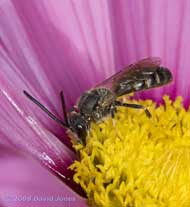
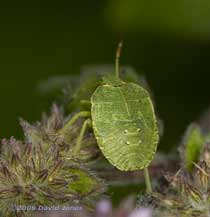
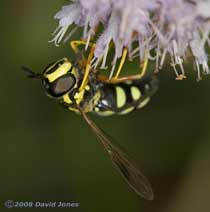
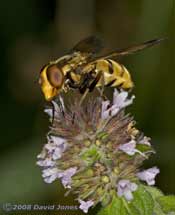
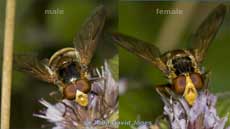
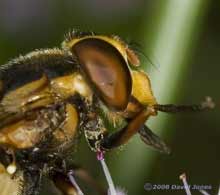
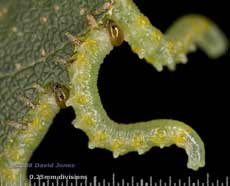
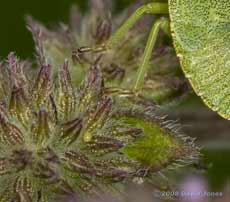
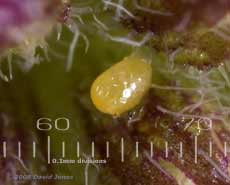
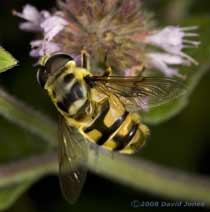
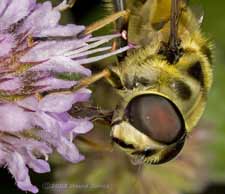
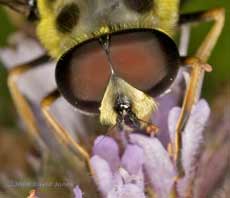
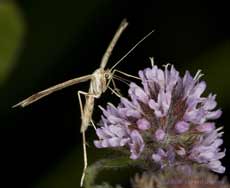
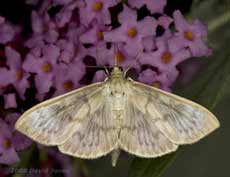
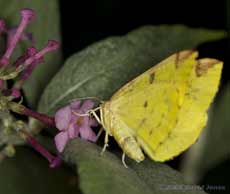
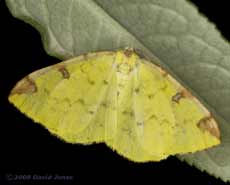
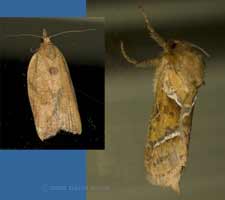
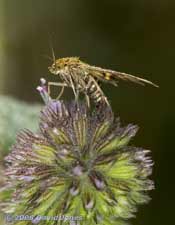
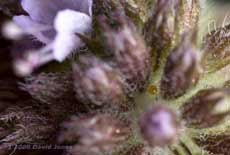
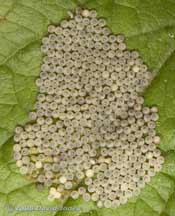
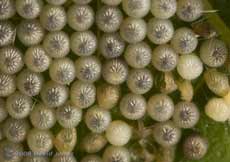
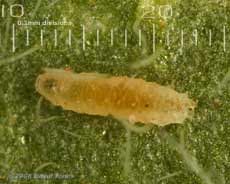 What
I also found on the underside of older leaves especially were numerous tiny
larvae, the largest measuring not much more than 1mm in length.
What
I also found on the underside of older leaves especially were numerous tiny
larvae, the largest measuring not much more than 1mm in length.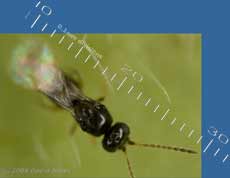 On
the same leaf was another tiny insect, this time an adult wasp-like insect,
slightly longer than the larvae at just under 1.4mm (excluding the
antennae).
On
the same leaf was another tiny insect, this time an adult wasp-like insect,
slightly longer than the larvae at just under 1.4mm (excluding the
antennae).